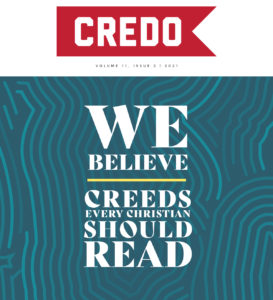The Apostles’ Creed is a summary confession of vital Christian doctrines used liturgically throughout the Western church. It was once believed that the Creed originated with the apostles on or around Pentecost, but now most historians reject this view, seeing the Creed as containing the apostolic faith while not actually having been written by the apostles themselves.
The Background to the Apostles’ Creed
How did the Creed originate? First, it is important to recognize that creedal formulations are common in holy Scripture. The Hebrew shema of Deuteronomy 6:4 was itself a kind of confessional statement used daily by pious Hebrews. The language of 1 Corinthians 15 is creedal, where Paul mentions the transmission of the gospel message which he received and passed on to the Corinthians.[1] Brief summaries of the faith were used devotionally and liturgically under the old covenant, and later among the apostles. It makes sense then that the church would adopt this custom.
In the postapostolic period, the need for clear and concise articulations of the faith was due in part to the rapid growth of the church throughout the first few centuries of her existence. It is widely believed that the Apostles’ Creed evolved as a kind of baptismal confession. The articles in the Creed were the elementary principles of the faith which the catechumenate – think ancient new members class – were instructed in prior to being baptized. After a period of learning, they would confess the Creed and then receive the sacrament.
Does this ancient Creed really contain the apostolic “ABC’s” which the first Christians taught initiates? Yes! Consider what the author to the Hebrews said,
Therefore let us leave the elementary doctrine of Christ and go on to maturity, not laying again a foundation of repentance from dead works and of faith toward God, and of instruction about washings, the laying on of hands, the resurrection of the dead, and eternal judgment. (Heb. 6:1-2)
From as early as Hebrews was written, the foundational doctrines taught to new converts centered on Christ, repentance, faith toward God, instruction about washings (perhaps an allusion to sacramental theology?), the laying on of hands (ordination and ecclesiology?), the resurrection of the body, and the life everlasting. These fundamental teachings (all of which are present in the Apostles’ Creed) made up what the Fathers referred to as the regula fidei, or Rule of Faith. Men like Irenaeus and Tertullian believed this Rule had come down from the apostles, and that they were passing the baton to subsequent generations. The holy deposit of “Father, Son, and Holy Spirit; the life, death, and resurrection of Jesus Christ”[2] matured into creeds like the Apostles’ Creed between the 4th and 6th centuries, although each article of the Creed traces its lineage to the earlier teachings of Scripture.
The Articles of the Apostles’ Creed
The Creed puts forward twelve articles of faith (at one point it was believed that each apostle had contributed an article), and there are three main sections in the Creed. The first section begins with God the Father, and the work of creation; the second with Jesus Christ, and the work of redemption; and the third with the Holy Spirit, and the work of sanctification.[3]
I believe in God, the Father almighty,
creator of heaven and earth.
Throughout the history of the church, commentators on the Creed have begun by defining what it means to believe. Belief includes assent (i.e. agreeing with or approval of), but it isn’t exhausted by it. The Creed isn’t simply a set of propositions for us to say “amen” to, but the faith once for all delivered to the saints through which we experience communion with God and one another. In explaining what it means to believe, 16th-century theologian Caspar Olevian wrote, “Faith is to acknowledge and rest in the unchangeable will of God, namely; that He will graciously give us the salvation promised through the prophets and presented in reality through Christ, as the Articles of the Faith testify.”[4] Biblical belief lays hold of faith’s content and makes it one’s own.
The first object of our faith in the Creed is God the Almighty Father. He is a Father in two senses, first, by his personal relationship to the Word, the Second Person of the Holy Trinity. Because the Word is eternally begotten, the Father is always Father. Second, as to our adoption through Christ, he is the Father of all the faithful. Christ who is by nature the Son of the Father, makes us sons and daughters by grace (Jn. 20:17; Gal. 4:4-5; Eph. 1:5). The first object of our faith in the Creed is God the Almighty Father. Click To Tweet
The emphasis on God’s creative majesty echoes the opening line of Genesis, “In the beginning, God created the heavens and the earth.” We confess God as Cosmic-King without rival who made everything from nothing. This is hinted at by the identification of God as almighty. St. Augustine noted that the creation of the world ex nihilo (from nothing) reveals to us the absolute independence of God. “For granting that he is almighty, there cannot exist anything of which he should not be the Creator.”[5]
Embedded in this identification of God as Creator is also his providential rule over creation. The One God and Father who made all things is also intimately involved with the world he made, down to the seemingly insignificant occurrences of life (Prov. 16:33; Mt. 10:29).[6] This first section is a comfort to the church in that it introduces us to the God who not only rules over all, but cares for his creation.
I believe in Jesus Christ, his only Son, our Lord,
who was conceived by the Holy Spirit
and born of the virgin Mary.
He suffered under Pontius Pilate,
was crucified, died, and was buried;
he descended to hell.
The third day he rose again from the dead.
He ascended to heaven
and is seated at the right hand of God the Father almighty.
From there he will come to judge the living and the dead.
The importance of a “right confession” about Jesus is something we’re reminded of in the New Testament. When our Lord asked Peter, “But who do you say that I am?” Peter replied, “You are the Christ, the Son of the living God.” (Mt. 16:16) Paul told Timothy, “Great indeed, we confess, is the mystery of godliness: He was manifested in the flesh, vindicated by the Spirit, seen by angels, proclaimed among the nations, believed on in the world, taken up in glory.” (1 Tim. 3:16) In this section of the Creed, we embrace the apostolic teaching on Jesus’ identity, incarnation, humiliation, and exaltation contra the numerous Christological heresies that have attempted to subvert orthodoxy.[7]
To confess Jesus as Christ is to recognize his anointed status and threefold office as Prophet, Priest, and King. He fulfilled these offices in the economy of salvation, and continues to occupy them presently at the right hand of the Father. As Prophet, Jesus revealed to us the mysteries of God’s kingdom; foretold what his church on earth would experience throughout history; and exhibited the holiness and miraculous nature of the prophetic life. As Priest he offered himself up through the eternal Spirit as a once-for-all sacrifice of atonement; he prayed for his disciples, and is praying for the church presently from heaven; and he blesses his people. As King he prescribed his sacred laws for us; governs his people through those laws and by means of his word and church officers; and protects his people against all enemies.[8]
To confess that Jesus is the only Son of the Father echoes the language of John in John 1:14, 18; 3:16, 18 & 1 John 4:9. While we are the children of God through the grace of adoption, the Word is the Father’s eternally begotten Son by nature. This begotteness was before all worlds, highlighting the Word’s preexistence and eternal relation to God the Father. This eternal Word was “born twice,” eternally of the Father, and in time through the womb of the Virgin from whence he assumed humanity by the power of the Spirit (see Luke 1:35; John 1:14). The Word’s union with humanity through the incarnation was the inception of redemption accomplished. While we are the children of God through the grace of adoption, the Word is the Father’s eternally begotten Son by nature. Click To Tweet
The Creed moves quickly from the cradle to the cross, focusing on Christ’s sufferings and then his exaltation. What are we to make of the controversial phrase, “he descended to hell”? Some hear this and imagine Christ enduring a fiery torment in the time between his death and resurrection. This idea is biblically untenable and has never been in consideration for orthodox Christians. Jesus made it clear that after enduring our curse on the cross he would be in paradise, not perdition (Lk. 23:43). Some, like Calvin, argued the descent to hell referred to Christ’s sufferings on the cross. Others have understood the phrase to refer to Christ descending to the place of the dead victoriously in order to release those believers who had anticipated his coming. This view sees triumph, not torment in Christ’s descent, and may find support in places like Ephesians 4:9 and 1 Peter 3:18-22.[9]
The language of descent is followed by resurrection, ascent, Christ’s session at the Father’s right hand, and his future judgment. These realities encompass Christ’s exaltation and were commonly mentioned in the liturgical formulae of apostolic times (1 Cor. 15:3-4; 1 Tim. 3:16; Phil. 2:6-11).
I believe in the Holy Spirit,
the holy catholic church,
the communion of saints,
the forgiveness of sins,
the resurrection of the body,
and the life everlasting. Amen.
The final section of the Creed brings us to the Holy Spirit. The trinitarian structure of the Creed is in keeping with the language of the New Testament (see Matthew 28:19; 2 Corinthians 13:13; 1 Corinthians 12:4-6; 2 Corinthians 1:21-22; Ephesians 4:4-6).[10] The Spirit is called holy not because he is more holy than the Father, or the Son, but because “according to the economy of the Divine operations, the sanctification of believers is usually attributed to the Spirit.” (1 Cor. 6:11; 2 Thess. 2:13)[11]
The primary sphere of the Spirit’s sanctifying work is the holy catholic church. Here, two attributes of the church are named: holiness and catholicity.[12] The church is holy through her union with Christ and the Spirit’s vivifying presence. She is catholic insofar as she is not confined to one nation, or place; but made up of those from all nations who call upon the Lord with true faith, together with their children.[13] The Spirit applies the benefits of Christ’s redemptive work to the people of God, granting the whole church – militant and triumphant – a blessed union that we should embrace and strive to maintain on earth with peace. This union flows from the forgiveness of sins and sets our hope on the future glory to be experienced at the consummation: the resurrection of the dead and the life of the world to come.
How to Make Use of the Apostles’ Creed Today
I want to suggest we recover the usage of the Apostles’ Creed in three ways: In our personal devotions; as a guide for instructing new believers; and as an act of corporate worship.
Individually, daily confession of the Creed can be a stabilizer amidst life’s challenges. Reminding ourselves of the faith and affirming it before God is a way of setting our hopes on the Trinity and his kingdom. When you wake up in the morning, confess the Creed, and rejoice that yours is the faith of the apostles and martyrs. Men and women with whom you have communion, and a common faith! St. Augustine encouraged this use in a sermon on the Creed to catechumens, “Receive, my children, the Rule of Faith, which is called the Symbol (or Creed). And when ye have received it, write it in your heart, and be daily saying it to yourselves; before ye sleep, before ye go forth, arm you with your Creed.”[14] Reminding ourselves of the faith and affirming it before God is a way of setting our hopes on the Trinity and his kingdom. Click To Tweet
There’s also wisdom in using the Creed as it was originally intended: as instruction for new believers. Churches that are looking to reformat their new members class (or create one from scratch) can adopt the Creed and lead inquirers through the apostolic ABC’s. In our day, many of these vital doctrines are under attack. Fortifying the faithful from the very beginning with the Creed is as important now as it ever was. Both for their protection, and sanctification.
Lastly, we should make use of the Creed in our worship services. If this is new for your church, I’d suggest having a midweek study, or Sunday School class on the Creed; introducing its history and content prior to adopting it in the liturgy. As we teach the faith, we enable our people to heartily confess it. The Apostles’ Creed isn’t a relic from long ago, it’s the faith of the universal Christian church today; it’s our faith. We should know it, teach it, and confess it.
Endnotes
[1] The Greek word used by Paul in 1 Corinthians 15:3, paradidomi was often used to describe the transmission of written tradition or creedal statements (See 1 Corinthians 11:2, 23; Romans 6:17; Jude 1:3).
[2] See Pelikan, Jaroslav The Emergence of the Catholic Tradition, 117.
[3] See Heidelberg Catechism question 24.
[4] Olevian, Caspar An Exposition of the Apostle’s Creed.
[5] See Augustine, De Fide et Symbolo, Ch. 2
[6] For an edifying discussion on this, see Olevian’s Exposition where he gives five key takeaways from God’s providence: 1) It highlights God’s intimate involvement in the world. 2) It reveals that everything tends toward the salvation of God’s elect. 3) It reveals God’s control over the actions of those around us. 4) It reveals God’s control over the angelic realm. 5) It encourages the use of God’s appointed means for growing in grace, rather than fatalistic laziness.
[7] It’s amazing to see how this simple confession lays to rest a whole host of heresies. In his exposition of the Apostles’ Creed, Thomas Aquinas spells out how this section refutes the Christological heresies of Photinus, Sabellius, Manicheus, Ebion, Valentinus, Arius, Apollinarius, Eutyches, and Nestorius. See The Sermon-Conferences of St. Thomas Aquinas on the Apostles’ Creed (T. Nicholas Ayo, C.S.C.) Wipf & Stock pgs. 47-61.
[8] These descriptions of Christ’s threefold office are taken from Herman Witsius’ Sacred Dissertations on the Apostles’ Creed Volume 1 Reformation Heritage Books pgs. 265-290.he
[9] For a version of this view, see Thomas’ Sermon-Conferences pgs 79-81, and for a more recent defense see Matthew Emerson’s ‘He Descended to the Dead’: An Evangelical Theology of Holy Saturday 2019.
[10] A great introduction to this is Gilles Emery, O.P. The Trinity An Introduction to the Catholic Doctrine of the Triune God The Catholic University of America Press pgs. 51-55
[11] Witsius Dissertations Volume 2 pg. 306.
[12] The Nicene Creed adds two others: oneness and apostolicity. The marks of the true church are the right preaching of the word, the right administration of the sacraments, and biblical discipline. The attributes of the true church are oneness, holiness, catholicity, and apostolicity.
[13] See Westminster Confession of Faith 25.
[14] See the introduction of St. Augustine’s De Symbolo ad Catechumenos.


